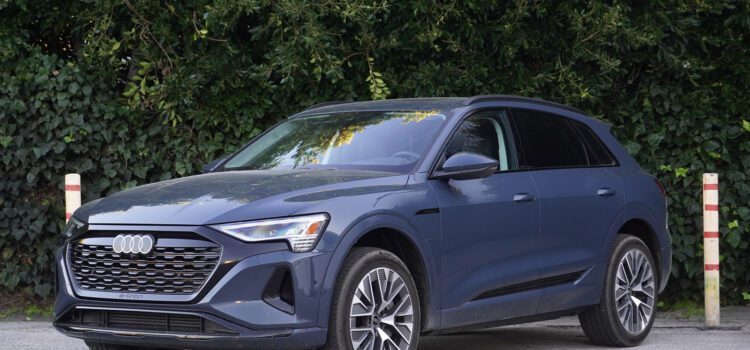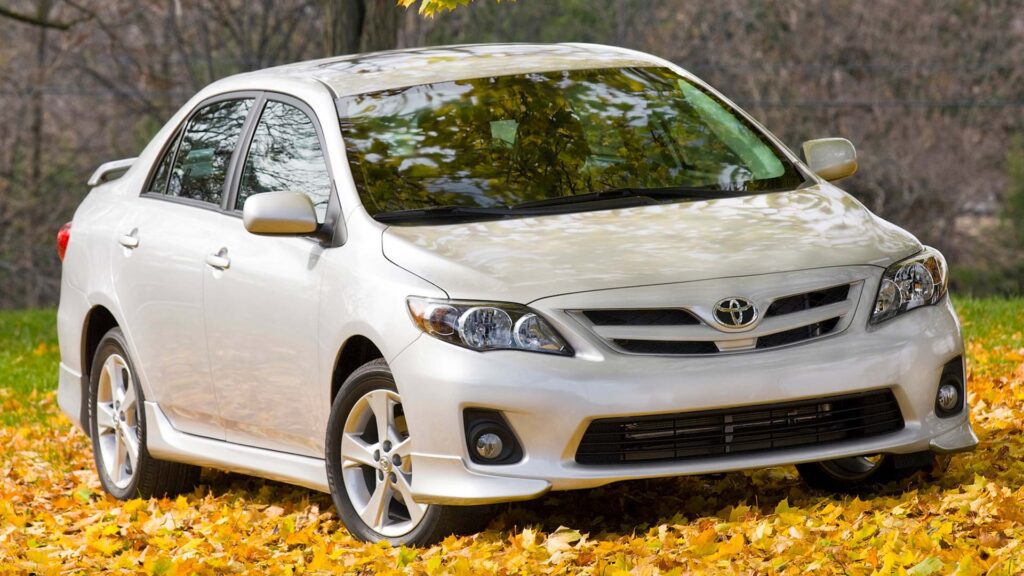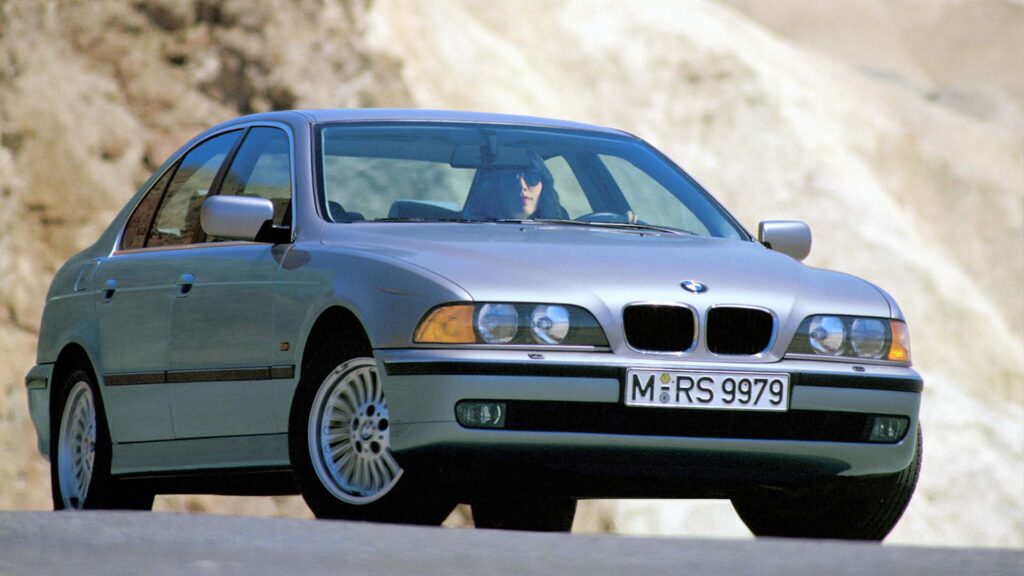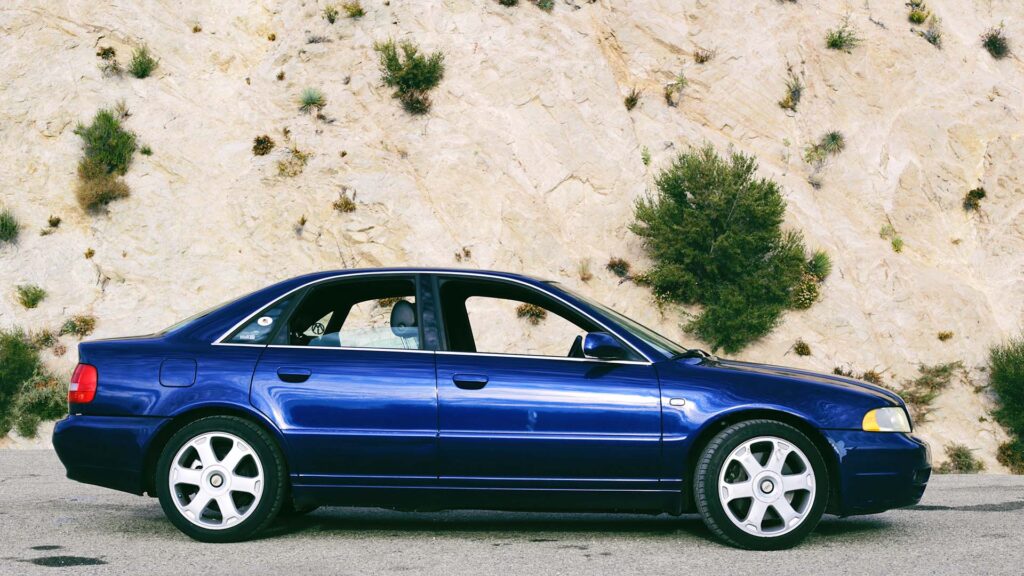2024 Audi Q8 e-tron nails everything but range… But that’s not the point
The longtime knock against Lamborghini’s Urus SUV has been that buying an Audi RSQ8 delivers seven-eighths of the car for about half the money. Not that such things bug Lambo owners, but what if the all-electric Q8 e-tron with gobs of low-end torque could keep up while drag racing against an Urus?
Now, Audi sells a re-named version of the EV formerly known as e-tron. The newly minted Q8 e-tron comes with the choice between a Sportback roofline or a taller SUV canopy that cuts into range estimates ever so slightly. Neither, however, can hold a candle to a Lamborghini Urus in a straight line or while canyon carving and unimpressive EPA range numbers for both are something of a bummer—but that’s not the point here.
Instead, Audi clearly built the Q8 e-tron hoping to entice any lingering holdouts among luxury urban buyers looking for the perfect EV to haul the fam, go grocery shopping, or take out for nights on the town. And in those regards, this luxury SUV from Audi—which just happens to be electric—absolutely nails the brief.
Skip to section:
Price & Specs
[Button id=”464″]
| Base price: | $74,400 |
| As-tested price: | $88,990 |
| Motor/battery: | Dual motor + 114 kWh lithium-ion battery pack |
| Transmission: | single-speed |
| Drivetrain: | e-Quattro all-wheel drive |
| Power: | 355 horsepower; 402 horsepower w/ Boost mode |
| Torque: | 414 pound-feet; 490 horsepower w/ Boost mode |
| Weight: | 5,798 pounds |
| 0-60 mph: | 5.4 seconds |
| ¼-mile: | 13.9 seconds @ 101 mph |
| Top speed: | 124 mph |
| MPGe: | 80 city, 83 highway, 81 combined |
| Range: | 285 miles |
Audi Q8 e-tron exterior design
The Q8 e-tron’s styling winds up simultaneously similar to both the former e-tron SUV and all the Q8/SQ8/RSQ8 siblings. Not quite as aggressive as the range-topping RSQ8—nor the Urus, obviously—the electric version still sports subtle fender flares and a statuesque profile, especially with the air suspension pumped up to the highest setting. A closed-off grille and lack of exhaust tips serve as the main hints that an electric drivetrain hides beneath the crispy skin.
This loaner from Audi arrived in a spectacularly understated “Plasma Blue Metallic” paint job (a $595 option well spent) that approaches shades of matte Nardo Blue in some lights with a hint of sparkle in others. And the 21-inch wheels might look simple from afar, but a closer inspection reveals pure sculptural art in rolling form.


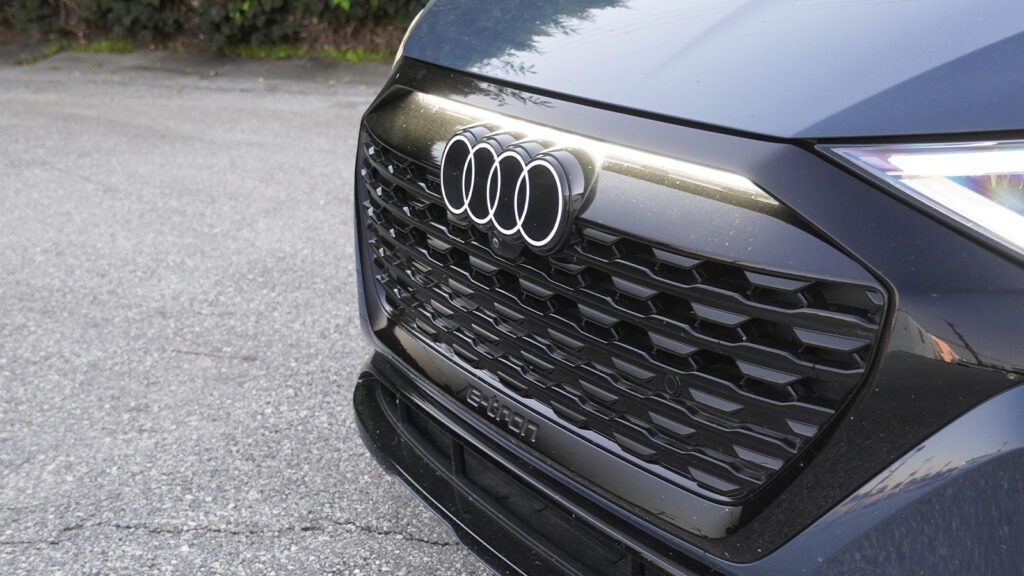
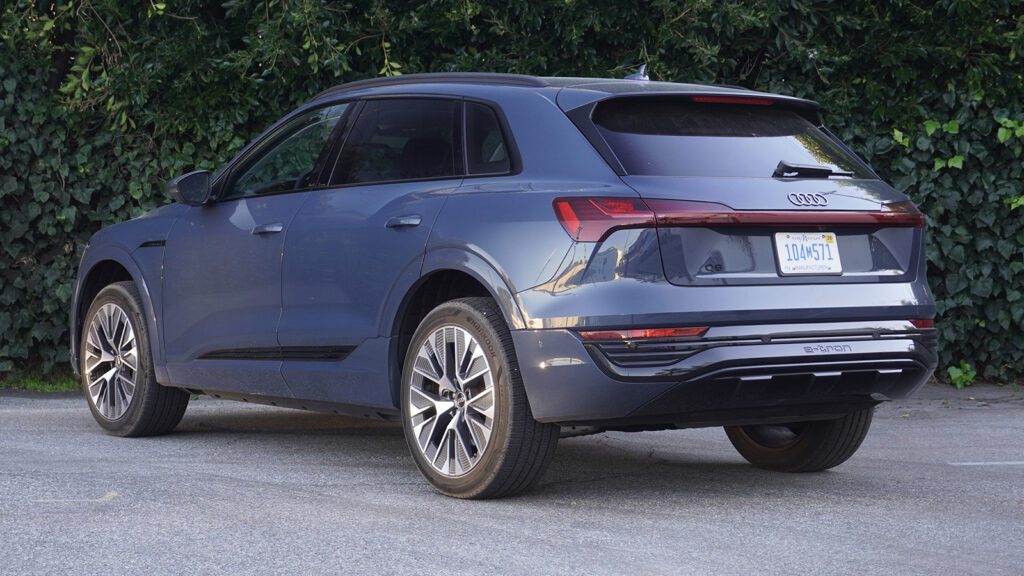
| What’s hot? | – Quintessential Audi design, inside and out – Buttery smooth ride, even on massive wheels – Absolutely silent and serene NVH – Spectacular heated, cooled, and massaging seats – Bang & Olufson sound system is all that much better in an EV |
Q8 e-tron pricing breakdown
The base Q8 e-tron starts at $74,400 before options and a $1,195 destination charge. Standard equipment includes a 114-kWh lithium-ion battery, dual motors for single-speed Quattro all-wheel drive, and adaptive air suspension that raises and lowers the body depending on selection of drive modes. Ticking the box for the most opulent “Prestige package” adds another $10,400 to those numbers, which explains most of this loaner car’s $88,990 MSRP along with the Black optic package (another $2,000) and rear side airbags ($400).
Two years of free charging at Electrify America also come standard, and Audi’s four-year/50,000-mile warranty applies to everything on the car. To true buyers rather than lessors, the high-voltage battery is covered by an eight-year/100,000 warranty.
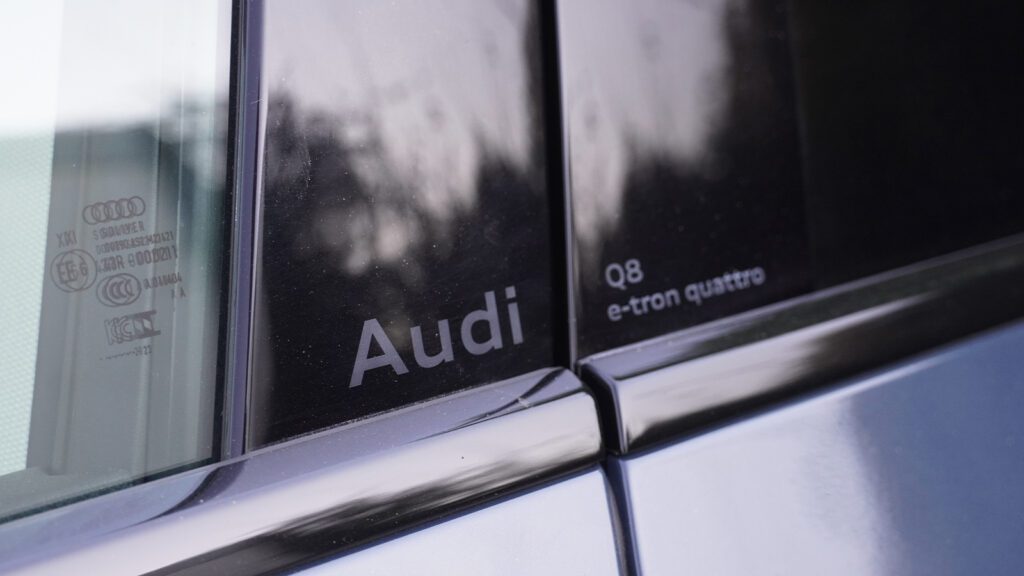
Q8 e-tron interior and tech
As usual for Audis since the first-gen TT back in 1998, the Q8 e-tron’s interior design stands out from the bland, overly plasticine era overtaking most luxury automakers. Plenty of leather and brushed trim abounds, though a few pieces of piano black plastic have snuck in here and there. Otherwise, the deft application of angularity and ergonomics leaves most controls sufficiently intuitive and satisfying to operate—other than the distant volume control knob, that is, another Audi standard for the past decade or so.
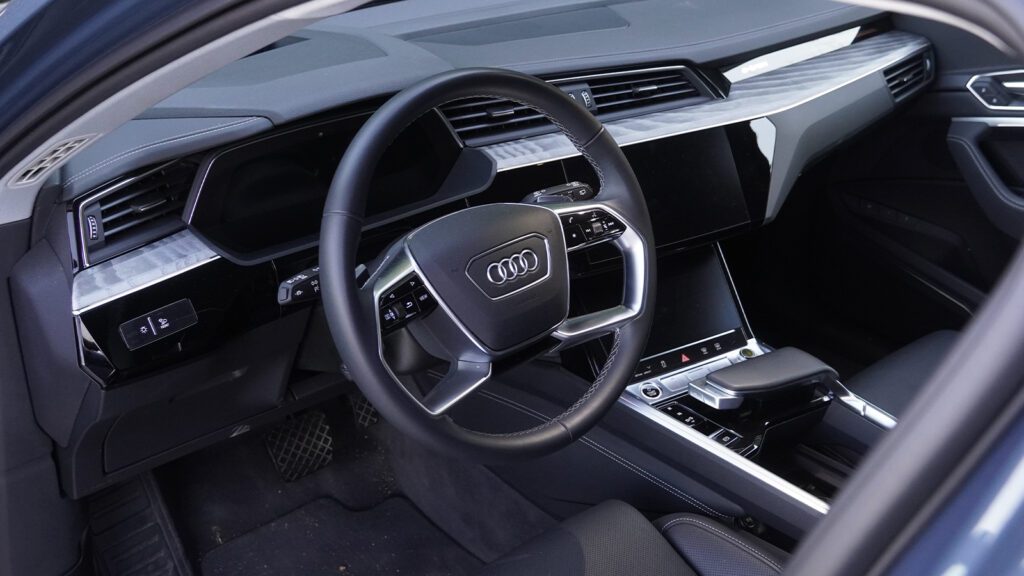
But maybe the highlight of the entire driving experience so often goes overlooked: the steering wheel. The Q8 e-tron sports a four-spoke design that offers multiple comfortable hand placement options, with minimal buttonry to get in the way. Then there are the seats, quite possibly some of the best in existence, and obviously equipped with heating, ventilation, and surprisingly firm massaging functions.
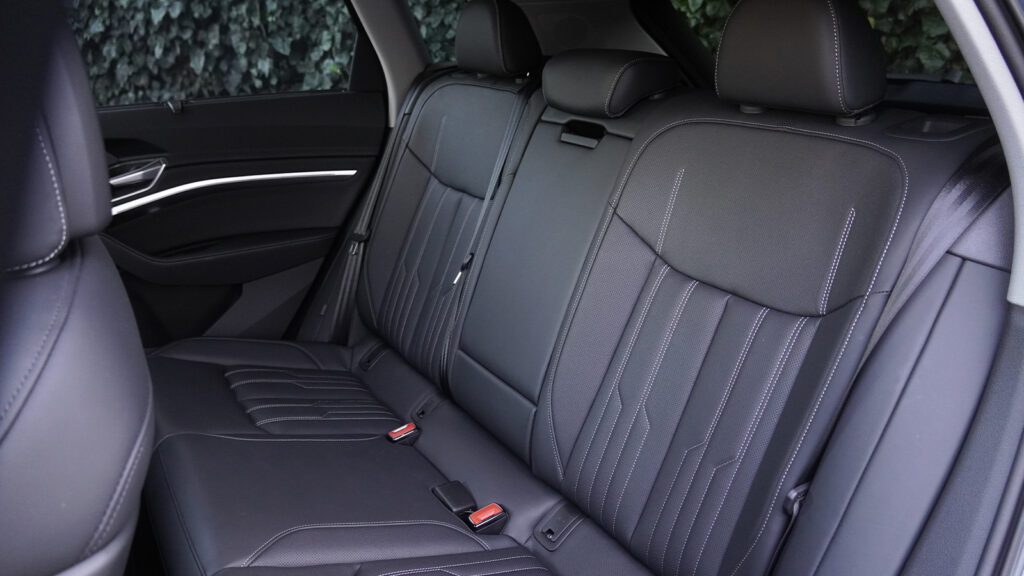
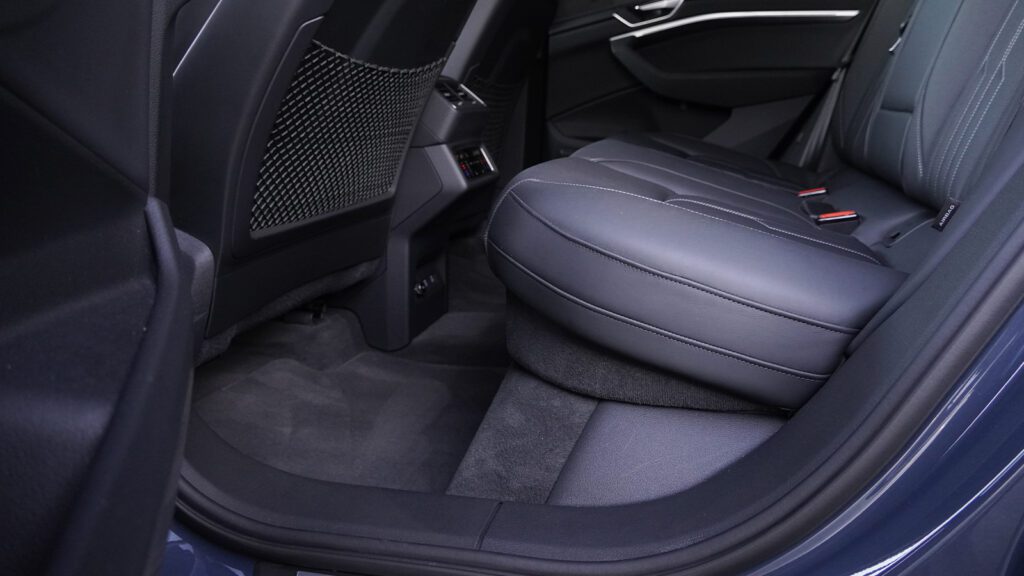
Onboard tech, however, falls a bit short by most modern EV standards. Sure, the dual touchscreens for climate control and infotainment require a pleasing amount of haptic pressure to actually make selections—but not always, sometimes only a light touch does the trick. For some reason, however, the Q8 e-tron forgets drive modes regularly enough to approach annoyance, requiring the constant selection of regen settings via paddle shifters even after just turning the adaptive cruise control on or off.
Lane keep assist also intrudes regularly, the seats find new positions upon every start-up (which might change for a more permanent owner using a consistent key), and the range estimate seems to vary wildly. Did the engineering team truly need to reinvent the shifter for the umpteenth time?
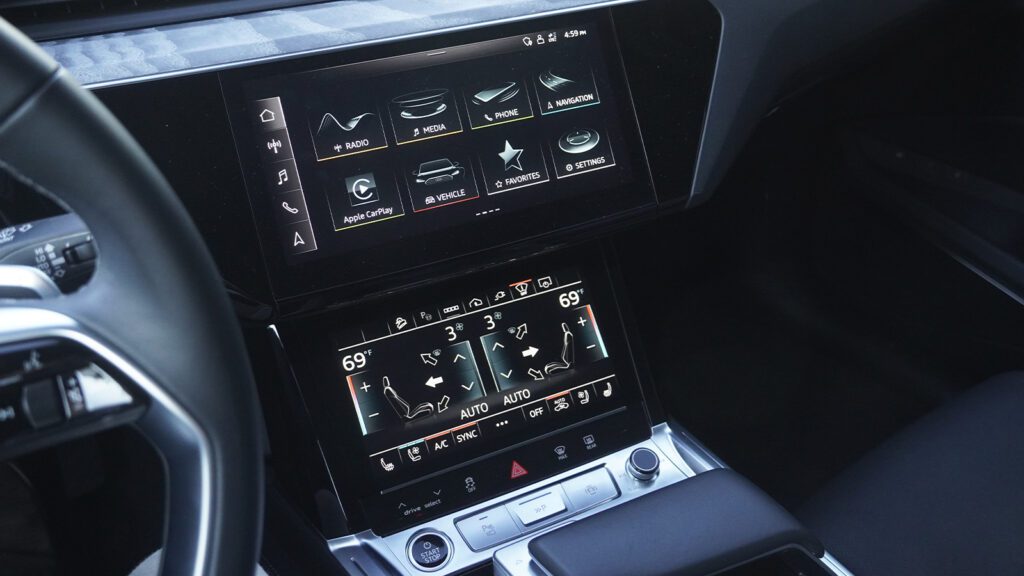
An EV for the last urban luxury holdouts
Slipping into the Q8 e-tron for the first time, a sense of serenity and confidence emanates from the entire interior. Luxury buyers not accustomed to the more typical over-technologized interiors of most other EV options might even be forgiven for struggling to recognize a difference between the controls for an internal combustion or all-electric Q8. Hell, there’s even a stop-start button!
Most importantly, anyone still poo-pooing the Q8 e-tron’s range estimate of 285 miles needs to take that initial impression into more consideration. The whole point of this car, clearly, is to convert any stubborn holdouts who simply don’t want to shift their thinking too much while making the switch to electrification. Audi even withheld aggressive regeneration, which means the Q8 e-tron cannot be driven in a full one-pedal mode.
Otherwise, the gauges and dash seem very familiar, halfway between an Urus and other Audi models. The interior even smells similar to a first-gen TT or a 2016 A3, despite the lack of gasoline, gear oil, and belts to warm up on a cold day. Similarly, the gauges offer multiple customizable readouts for either more or—to the point—less EV-specific information.
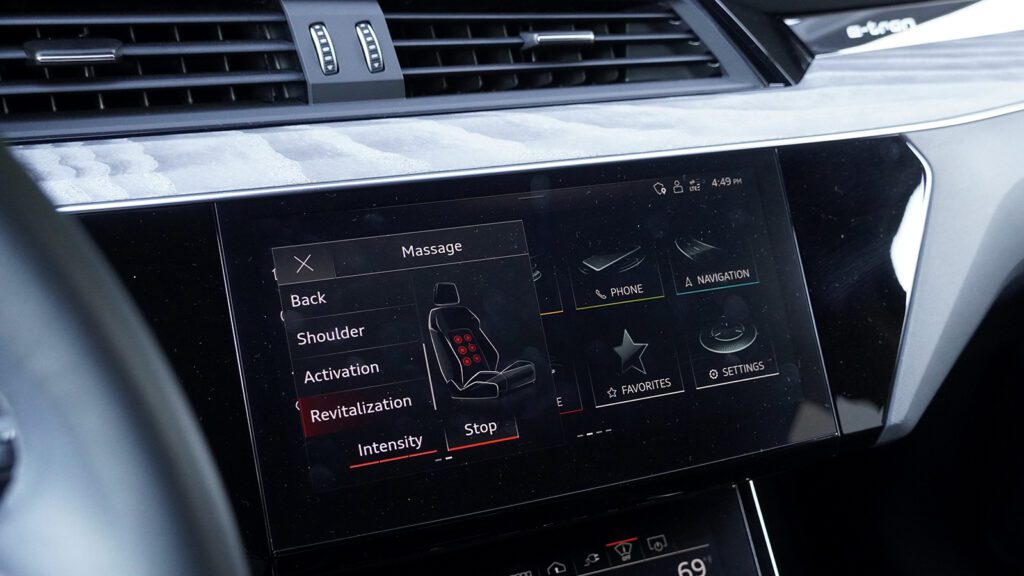
But the Q8 e-tron still prioritizes the benefits that electric cars offer, too. The large and spacious interior allows for plenty of legroom in the second row, which, when folded down, then opens up to a cavernous cargo area big enough for ski bags or bicycles. Even more importantly, this thing rides so damned quiet that the lack of sound can almost get creepy. Zero tire or wind noise until about 75 miles an hour absolutely bedevils the mind, especially compared to other EVs not named Lucid. Talk about NVH as a priority.
And the suspension rides in god mode, insanely smooth, given 21-inch wheels and 265-mm wide Hankook eco tires. Everything from asphalt ripples to pavement cracks and speed bumps simply evaporates. Only the most unpredictable road surfaces create the occasional rafting sensation when one wheel popping upward forces the entire skateboard chassis to lift noticeably.
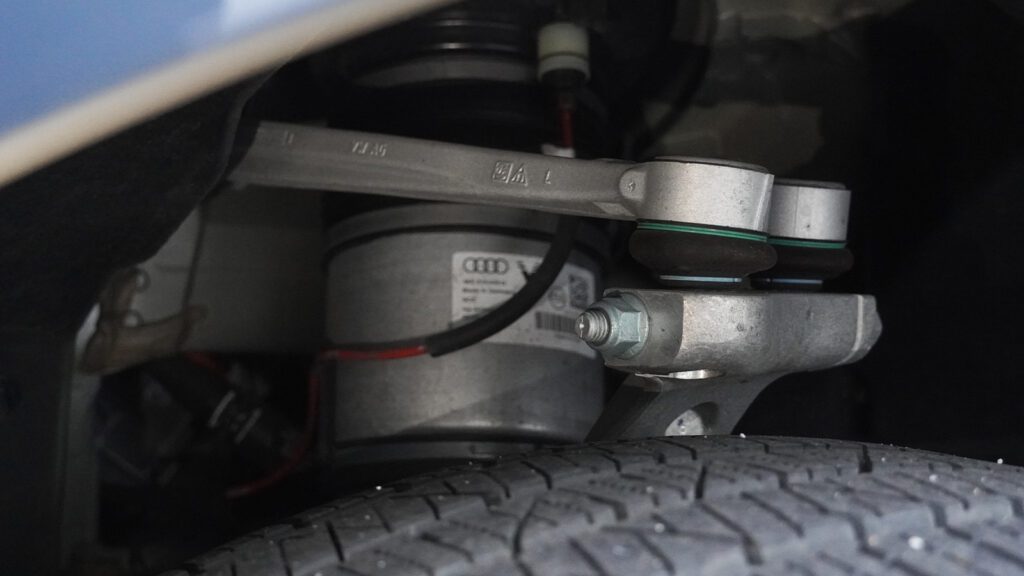
Power and range in line with ICE performance
For any EV aficionados, however, the Q8 e-tron’s power and range wind up on the slightly disappointing end, without a doubt. The dual electric motors deliver plenty of peppy acceleration, from a standstill or while passing at highway speeds, but nowhere near the neck-snapping jerk of other EVs at similar, and even lower, price points. Typically featherweight Audi steering actually becomes slightly firmer on center, then lightens up while whipping around corners. But those eco tires start to squeal early when pushed hard.
Switching between drive modes lifts the suspension’s ride height while adjusting throttle response and traction control modes. Out on the dirt roads of Johnson Valley, raised all the way up in “offroad” mode, the prospect of puncturing a low-profile tire prevented any true Quattro rally-racing shenanigans. And yet the air suspension and dampers still gobbled up washboards on rough graded surfaces with ease.
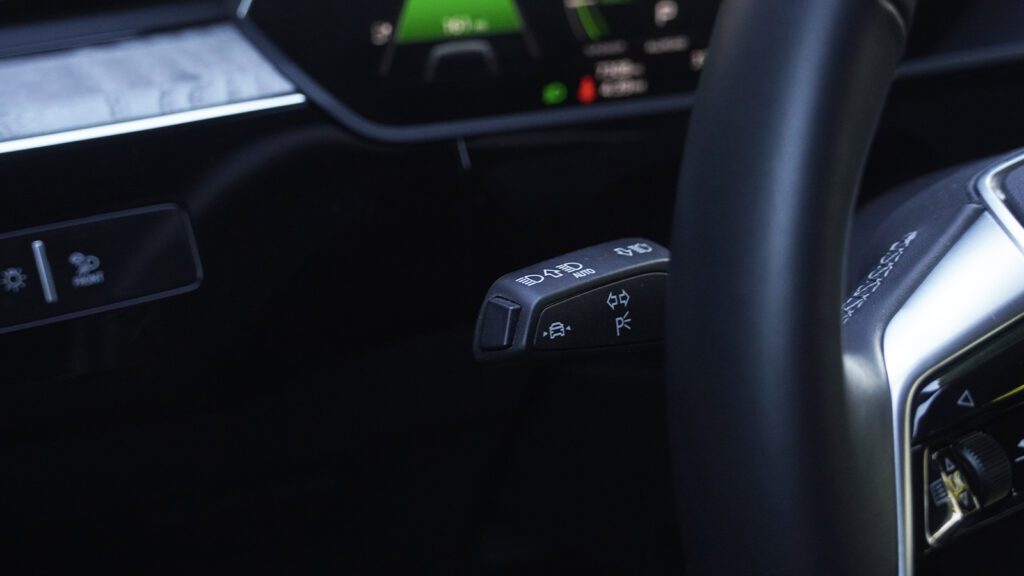

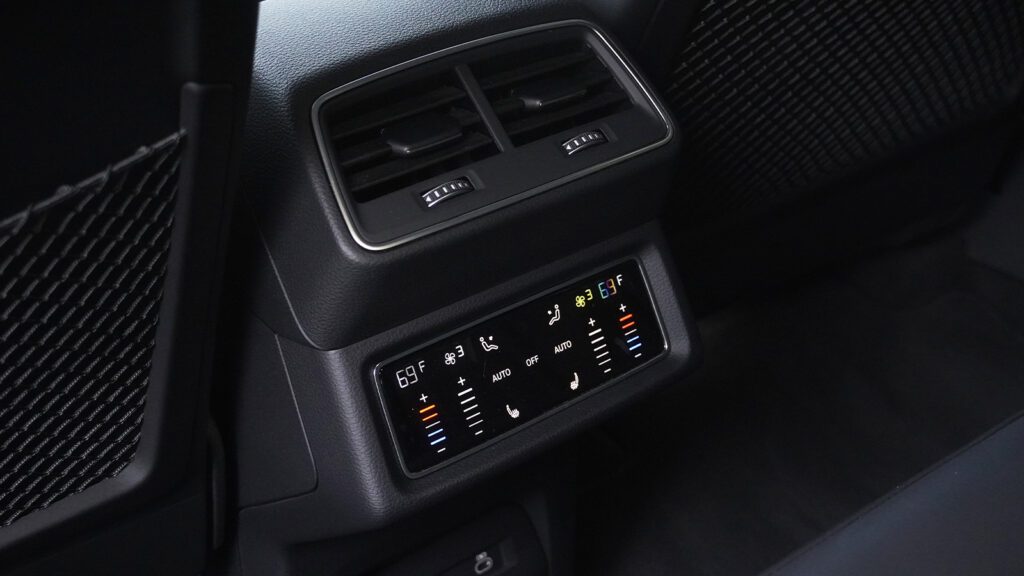

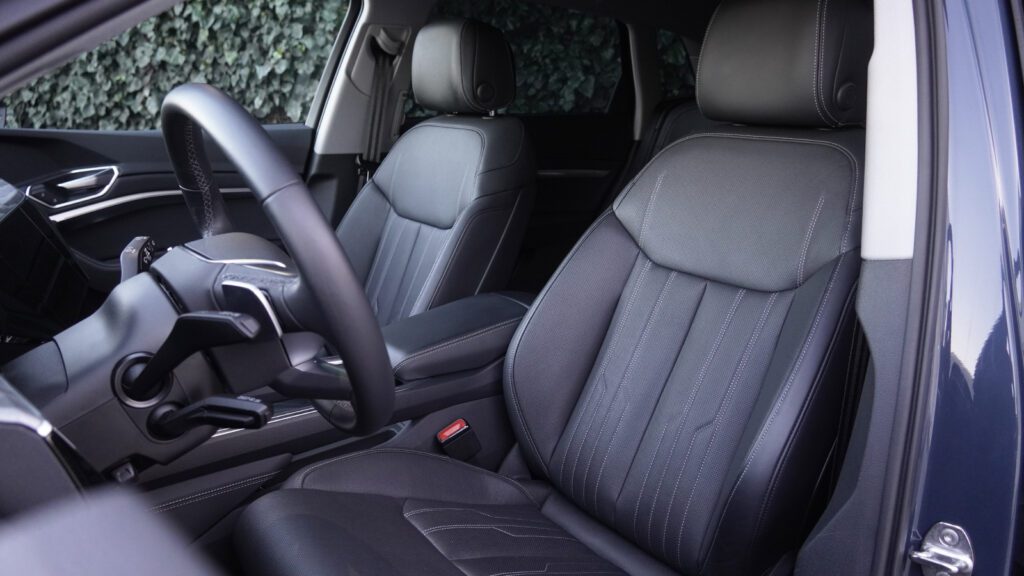
Most of the time, the Q8 e-tron putters around happiest in “efficiency” mode, which dulls down throttle response and lowers the suspension to minimize aero drag and maximize range. But on the drive out to Johnson Valley, the onboard range estimate’s programming almost immediately caused some serious range anxiety.
Theoretically, a 99% full charge with 280 miles of range remaining should be plenty to drive 135 miles at highway speeds. Yes, EVs run most efficiently in stop-and-go traffic, but come on now. Instead, almost immediately, the Q8 e-tron started eating through miles of range—to the point that only 20 miles into the drive, the estimated range left only 90 miles to spare. This is despite purposefully staying below 80 miles per hour.
Switching to Audi’s onboard MMI navigation, rather than using Waze through wireless Apple CarPlay, seemed to change the estimated range available as the computer took into consideration traffic and elevation changes. Around 65 miles later, with about 154 miles of range remaining, the situation started to plateau. But then, driving up the 15 Freeway towards Victorville restarted the range, plummeting to the point that hypermiling behind semi trucks seemed prudent (while searching for nearby Electrify America charging stations to use those two years of free charging).
Back at speeds below 60 miles per hour on State Route 247, the dissolving range once again settled down. Upon arrival at Johnson Valley, the range estimate still read 78 miles remaining. And then, on the last leg of the drive home, the remaining range actually increased over the total course of a 90-mile journey. Such wild fluctuations in Audi’s ability to predict range might not affect city slickers quite so much, and presumably, a family spending $90,000 on an EV commuter owns another car for road-tripping. But still, better programming would be nice—or maybe Audi just believes in ceding all trust to the machines.
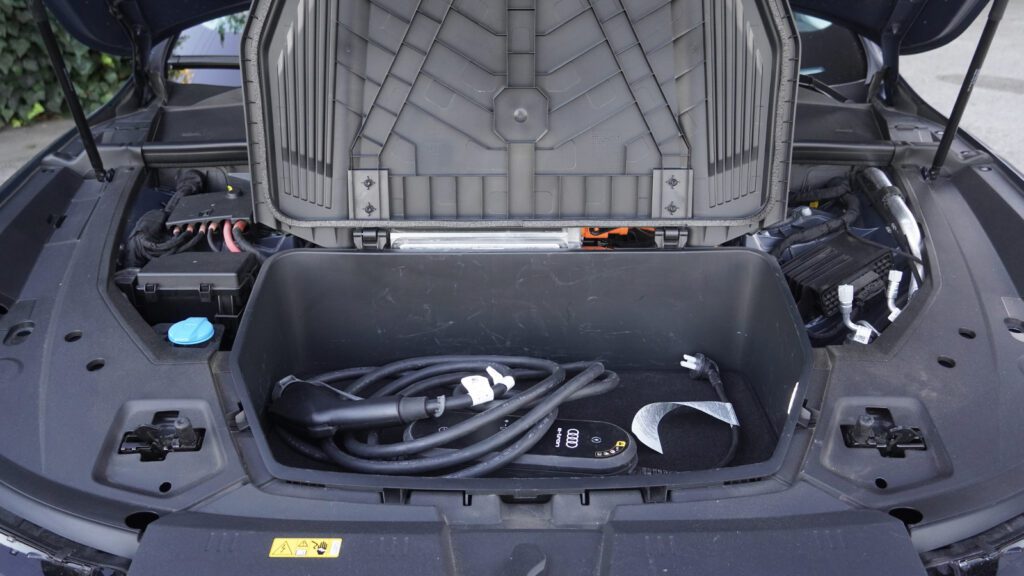


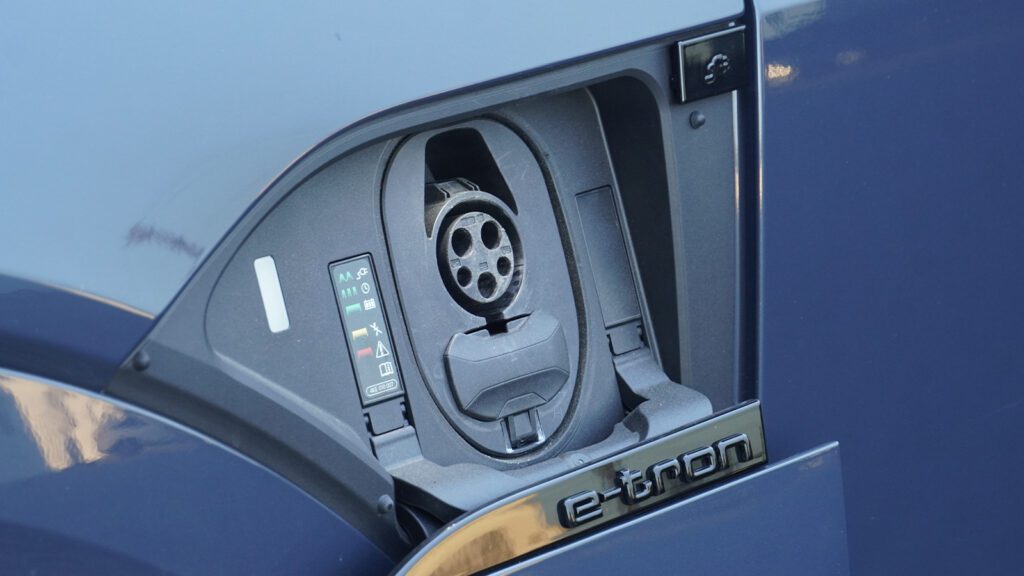
In town, while charging regularly at home or at the occasional fast charger, those 280 miles of range should serve 99% of owners just fine. Most range anxiety, after all, comes from false promises of a life lived on the adventurous edge. Even without a pre-conditioning button to push, the Q8 e-tron topped up from 66% to an overstuffed 99% at an Electrify America charger in Culver City in just 55 minutes. Not bad.
A few other general gripes might require a longer adjustment period than the mindset shift to EV life. Audi’s extremely aggressive driver aids—similar to the Urus, in fact—will absolutely yank the car away from lines on the road, to the point of pulling tires well into dangerous areas or cutting off lane-splitting motorcyclists regularly. (A button on the turn signal stalk turns off lane-keep assist, which cannot be controlled by any of the various settings deep in the MMI system either.) Automatic emergency braking can also sound and feel similar to tapping bumpers while parallel parking, partially because tipping into the go pedal afterward requires a bit more toe due to EV regen.
Lastly, the MMI regularly disconnected the entire smartphone interface with a warning banner, which required turning the car off and then on again, then re-connecting the Bluetooth (only possible when fully stopped, of course). This might just as likely be Tim Cook punishing any older iPhone users, though…

| What’s not? | – Range more akin to previous generation of EVs – No full one-pedal driving – Priced high as the market keeps expanding – Doesn’t remember drive settings at all, even between switching cruise control on then off – Infamous MMI glitches out and disconnects smartphone regularly |
[Button id=”465″]
Can luxury be defined at the right price?
In reality, nobody will mistake a Q8 e-tron for a Lamborghini Urus, and not just because of the mild EV whine. But similarities across the entire Volkswagen AG conglomerate do shine through, mostly for the better.
The question of Porsche’s newly announced Macan EV then starts to crop up. Sure, the Q8 e-tron is bigger by a fair amount, but the Macan’s 380-mile range capability adds to the impression that this Audi hails from a previous generation of electric vehicles—which it does.
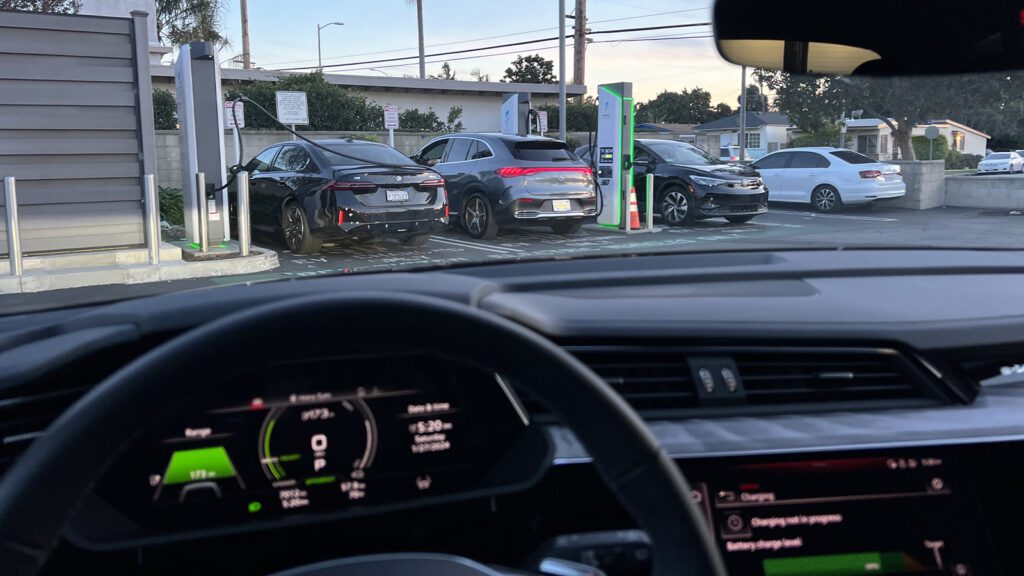
And yet, for the refined urbanite waiting to make the jump to an EV without giving up the familiarity of ICE cars, regardless of newfound nomenclature, the Q8 e-tron remains a solid option that delivers most of Audi’s strengths with just a few of the old weaknesses cropping up. In an increasingly crowded electric crossover-SUV market, such steadfast engineering likely combines the right attributes at the right price to stay fairly popular for the foreseeable future.

